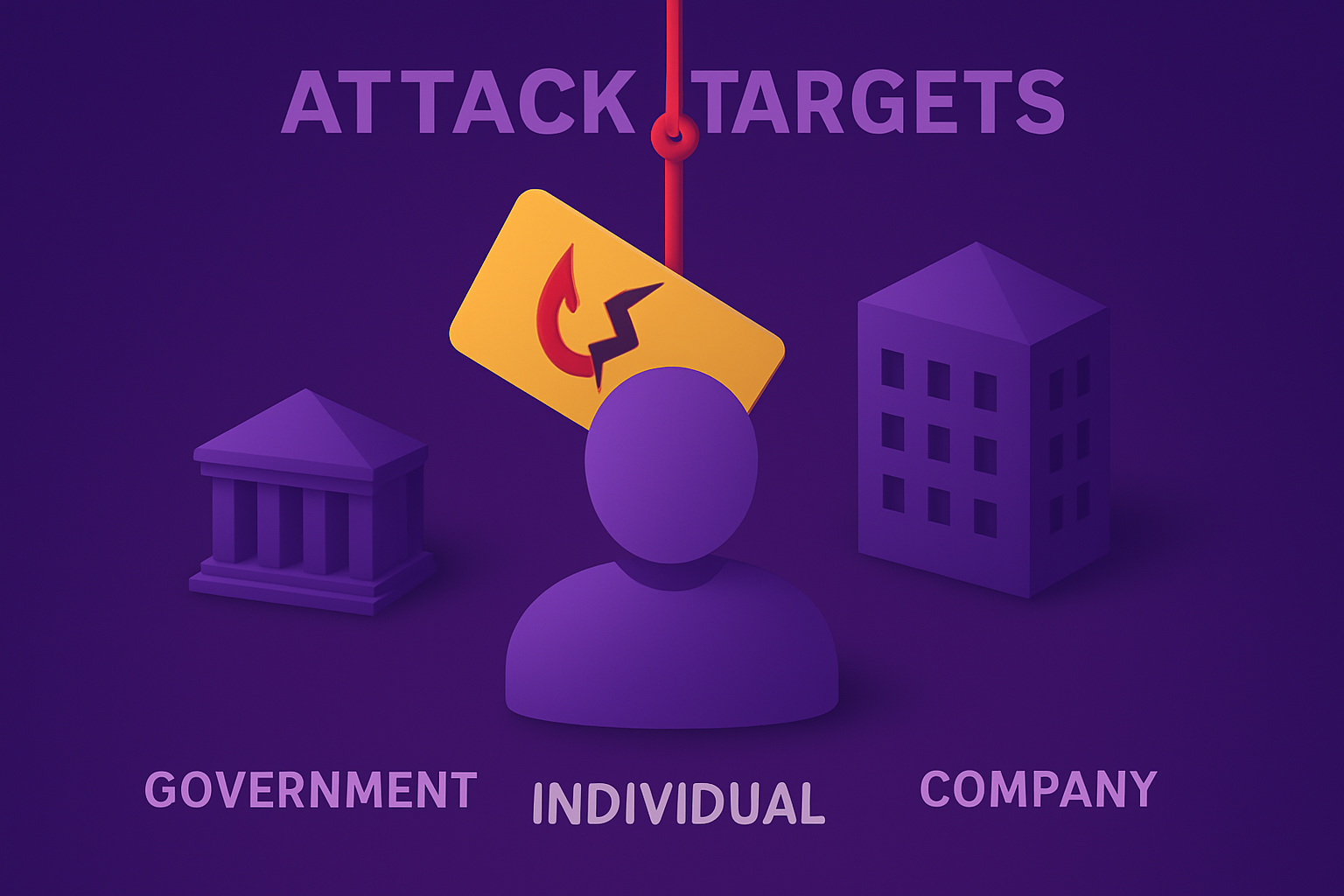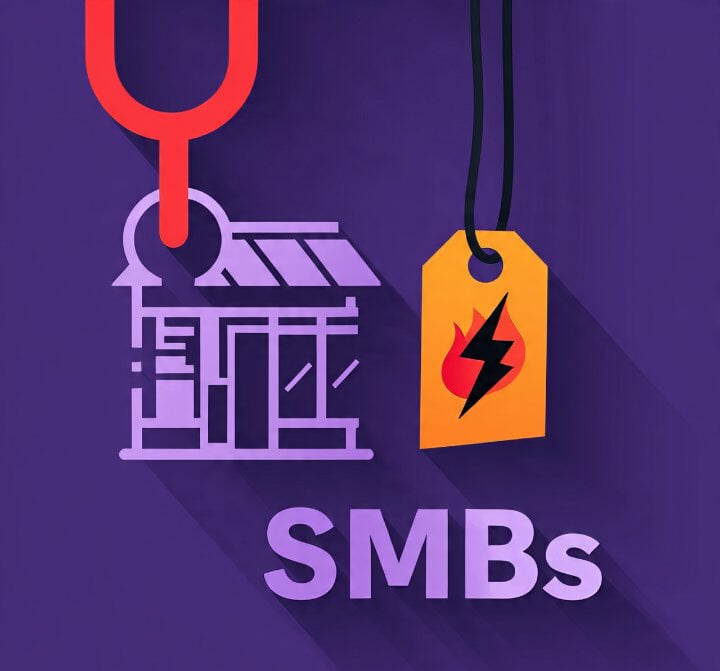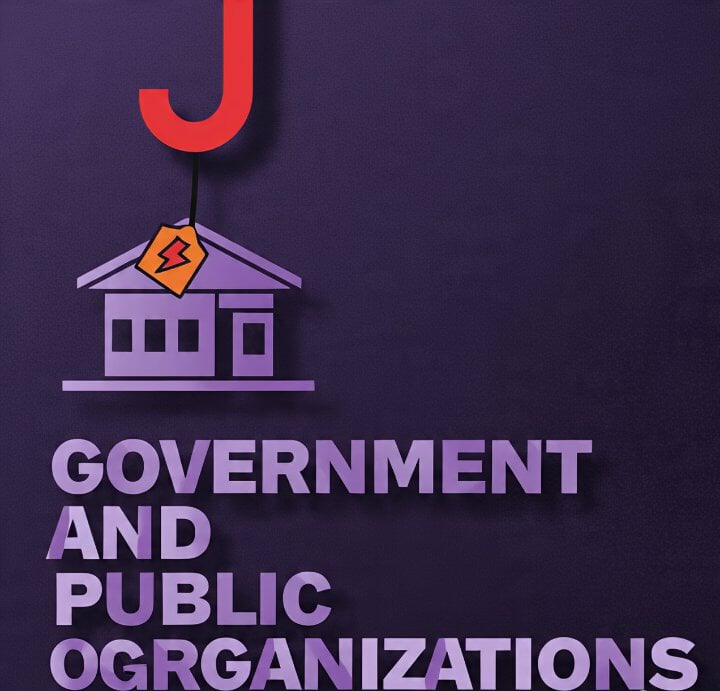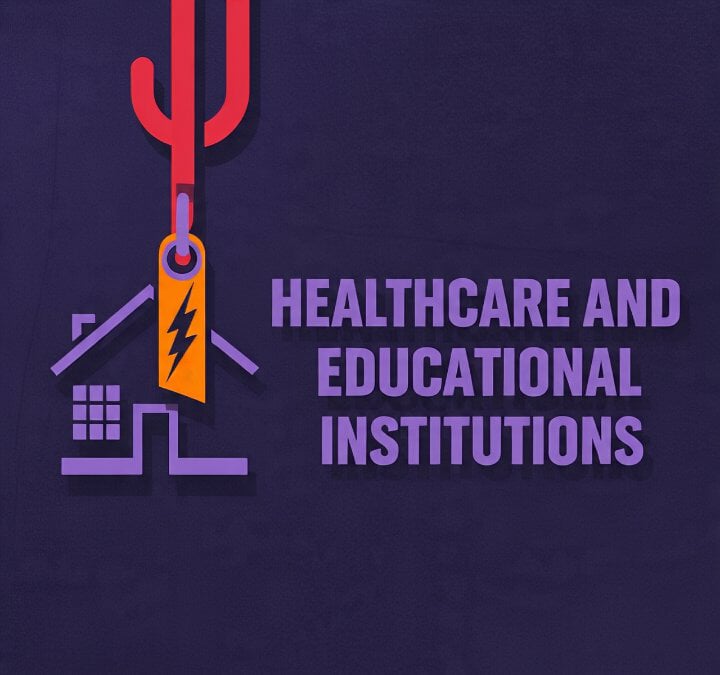
Attack Targets
In cybersecurity, attack targets refer to the specific systems, networks, devices, or data that cybercriminals aim to compromise. These targets are chosen based on their vulnerabilities, value, and accessibility. A cyberattack occurs when an attacker attempts to exploit weaknesses in a target to gain unauthorized access, disrupt operations, or steal sensitive information. The target could be an individual's personal device, an organization's network, or even a government system. The motivation behind these attacks varies, ranging from financial gain and espionage to political agendas and personal gains.
An entity becomes an attack target when it possesses exploitable weaknesses or high-value assets that can be leveraged by attackers. These vulnerabilities may arise from outdated or unpatched software, poorly configured security settings, weak or reused passwords, or simple human error—often referred to as the weakest link in cybersecurity. Cybercriminals often conduct extensive reconnaissance to analyze targets and uncover these weaknesses, using tools and techniques to probe for entry points. Common attack vectors include phishing schemes, malware infections, denial-of-service (DoS) attacks, and direct hacking attempts. Once a weakness is identified, attackers use it to breach defenses and achieve their goals. The potential impact of a successful attack depends on the importance and sensitivity of the target, making it vital for individuals, businesses, and governments to implement robust security protocols, stay updated on emerging threats, and foster a culture of cybersecurity awareness.
Types of Attack Targets
Cyberattacks can happen to anyone. Cybercriminals target a variety of people and organizations, each with its own set of reasons for being targeted. Factors such as the value of data, perceived vulnerabilities, or ideological objectives often influence why specific targets are chosen. Understanding these attack targets helps in developing effective security measures to prevent cyber threats.

1. Individuals
Factors That Make Individuals Targeted
Individuals are increasingly targeted in cyber attacks due to human error, such as clicking malicious links or using weak passwords. The value of personal data, like Social Security numbers and bank details, makes individuals prime targets for attackers. Many lack the awareness or training to recognize advanced threats, such as spear-phishing or social engineering. This combination of vulnerabilities and ignorance leaves people more susceptible to cybercrime.
Attack Methods
Cybercriminals exploit vulnerabilities through phishing, ransomware, and social engineering to steal sensitive information or demand payments. Malware and spyware track user activities to capture valuable data like passwords and banking details. Credential stuffing takes advantage of reused passwords to access multiple accounts.

2. Small and Medium-Sized Businesses (SMBs)
Factors Making SMBs Vulnerable to Cyber Attacks
Small and medium-sized businesses (SMBs) are often targeted in cyber attacks due to limited cybersecurity resources and expertise. They are seen as easy targets because they lack robust security measures, like firewalls or encryption, and may fail to update software, leaving systems vulnerable. Additionally, SMBs are more likely to pay ransoms to avoid costly disruptions, making them attractive to cybercriminals.
Attack Methods
SMBs are often targeted through tactics like impersonation, file-locking demands, manipulation, data theft, and the exploitation of reused passwords. These methods allow attackers to steal sensitive information, manipulate employees, and gain access to multiple accounts.

3. Large Companies
Factors That Make Individuals Targeted
Large companies are prime targets for cyber attacks due to their vast amounts of valuable data and resources. They often store sensitive information, such as customer data, intellectual property, and financial records, making them attractive targets for cybercriminals. They also face high-profile threats, where attackers aim to damage their reputation or disrupt business operations. Due to their size, large companies can be more profitable targets, with cybercriminals often demanding larger ransoms or stealing significant sums of money through fraud.
Attack Methods
Large companies are targeted when attackers deceive employees into revealing sensitive information, lock critical systems, or gain long-term access to steal data or disrupt operations. Servers are overwhelmed with traffic, causing service disruptions, and vulnerabilities in third-party vendors are exploited to impact the larger company.

4. Government and Public Organizations
Factors Making SMBs Vulnerable to Cyber Attacks
Government and public organizations are frequent targets for cyber attacks due to their access to sensitive national security information, citizen data, and critical infrastructure. These entities are high-value targets for cybercriminals, nation-states, and hacktivists who may seek to steal confidential information, disrupt government services, or cause political or social instability.
Attack Methods
Government and public organizations are targeted through deceiving employees into revealing sensitive data or access to tailored emails . Ransomware locks critical systems, demanding payment for release, while APTs provide prolonged access to steal or sabotage information. Nation-state actors often use these methods for cyber espionage or politically motivated attacks.

5. Healthcare and Educational Institutions
Factors That Make Individuals Targeted
Healthcare and educational institutions are frequent targets for cyber attacks due to the valuable and sensitive data they hold, including personal health records, research data, and student information. These sectors often have limited cybersecurity resources and outdated infrastructure, making them vulnerable to exploitation. Healthcare organizations are especially attractive because of the financial value of patient data on the black market. Educational institutions, on the other hand, may lack strong cybersecurity measures, with a high number of users and diverse networks, providing more entry points for attackers.
Attack Methods
Healthcare and educational institutions are targeted through various methods, including phishing to steal credentials, ransomware to lock critical data, and social engineering to manipulate staff or students into providing access to sensitive information. Attackers often exploit vulnerabilities in outdated systems and weak access controls to gain unauthorized access to valuable data.

6. Financial Institutions
Factors Making SMBs Vulnerable to Cyber Attacks
Financial institutions are highly regulated, making data breaches particularly damaging in terms of legal and reputational consequences. Because of the potential for financial gain through theft or fraud, including personal and financial information, transactions, and investment records. The complexity of their operations and large amounts of money flowing through their systems make them a high-value target for cybercriminals.
Attack Methods
Stealing sensitive information or disrupting operations aimed to disrupt financial institutions operations. They exploit weaknesses in financial software, payment systems, and mobile banking apps to intercept transactions or steal funds. Cybercriminals use phishing, ransomware, and social engineering to gain access to credentials, encrypt systems, or manipulate individuals into disclosing data.

7. Cloud Service Providers
Factors That Make Individuals Targeted
Cloud service providers (CSPs) are one of the attack targets since they host vast amounts of sensitive data for businesses and individuals worldwide. CSPs manage large-scale infrastructure and data storage; they are seen as valuable assets for cybercriminals seeking access to personal, corporate, or financial information. Furthermore, their interconnectedness with multiple clients makes them attractive targets for disrupting services on a wide scale or stealing data from numerous organizations simultaneously.
Attack Methods
Attackers gain unauthorized access to cloud systems by stealing credentials or exploiting misconfigurations in security settings. They target weaknesses in how cloud services interact with applications through APIs or exploit vulnerabilities in third-party integrations. These actions allow them to disrupt services, steal sensitive data, or corrupt stored information.
Prevention Strategies: Protecting Yourself from Threats
You don't have to be a cybersecurity expert to protect yourself from attacks. By adopting a few straightforward practices, you can significantly reduce your vulnerability to potential attacks and safeguard your personal and financial information. Here are steps anyone can take:
1. Use Strong Passwords
Make sure your passwords are strong and unique. Don't use the same password for everything, and consider using a password manager to keep track of them. Also, enable two-factor authentication wherever possible. This adds an extra layer of security.
2. Keep Software Updated
Always update your operating systems, apps, and antivirus software to make sure you have the latest security patches.
3. Be Careful What You Click
Be careful about clicking links in emails or text messages, especially if you weren't expecting them. If you're unsure, visit the website directly instead of clicking a link.
4. Use Antivirus and Anti-Malware Tools
Install good antivirus software and set it to update regularly. It helps protect your computer from malware and can catch suspicious activities.
5. Educate Yourself
The more you know about common cyber threats, the less likely you are to fall victim. Take some time to learn about the basics of cybersecurity.
6. Backup Your Data Regularly
Regularly backing up your important files. Use an external hard drive or a cloud service to store your backups securely.
Immediate Actions: What to Do After an Attack
1. Disconnect Immediately
If you suspect that your device has been infected or compromised, disconnect it from the internet to stop the attacker from causing further damage.
2. Report the Attack
Let the relevant people know right away. If you're part of a business, report it to your IT team. If you're an individual, contact your bank or service providers. You can also report cybercrimes to local authorities.
3. Change Your Passwords
If you believe your accounts are compromised, change your passwords as soon as possible. Focus on the accounts that hold sensitive information, like banking or email.
4. Assess the Damage
Take stock of what's been affected. If your files have been encrypted by ransomware, check if you have backups. If you don't, consult cybersecurity professionals for help.
5. Learn from the Experience
After the attack, review your cybersecurity practices and strengthen them. Update your passwords, improve your software, and make sure you're aware of the latest threats.
6. Consider Professional Help
If the attack was severe or you feel overwhelmed, don't hesitate to reach out to a cybersecurity expert. They can help assess the damage, remove malware, and implement stronger protective measures moving forward.
Key Takeaways
Cyberattacks can target anyone, from individuals to large organizations, based on the value of the information they hold or the potential impact of an attack. Common targets include individuals susceptible to scams, businesses with weak cybersecurity, and institutions like healthcare providers and financial organizations that store sensitive data. Attackers use various techniques to steal personal information, disrupt operations, or cause financial harm, exploiting vulnerabilities such as outdated systems and human error.
To protect against cyber threats, it's crucial to use strong passwords, stay alert to phishing scams, update software regularly, and employ antivirus tools. Cybersecurity is an ongoing effort, requiring vigilance, awareness of vulnerabilities, and proactive measures to stay protected in an increasingly digital world.